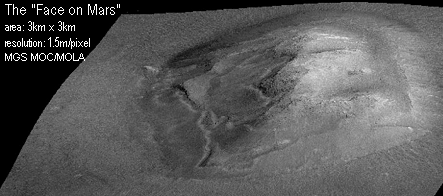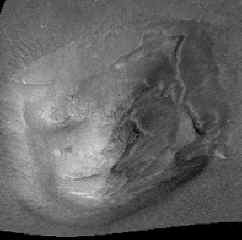How to Make a "Mountain" Out
of a MOL(A) Hill ...
When the new image of the Face on Mars was released in May, we had a right to expect (and hope) that it would be given a fair airing by NASA after nearly 20 years of controversy. Instead, as we predicted, we all watched as NASA went into a relentless spin cycle on the new image, trying very hard to suppress any idea in the public's mind that it might not be what NASA has always said it was -- "a funny looking hill." The linchpin of this NASA public relations fusillade was the (supposed) analysis of laser altimetry data from the Mars Global Surveyor's MOLA (Mars Orbiter Laser Altimeter) instrument, which according to NASA "showed there were no eyes, no nose, no mouth!"
As we have pointed out in two previous articles (The Face 2001 - More Evidence of the Internal NASA War?, and Yes Virginia, it Really is a "Catbox" ...), NASA's reliance on this data to "prove" anything about the Face is dubious scientific reasoning, at best. We have also called into question the fact that the images presented in the NASA hit piece (represented by NASA as being generated from MOLA) were both shown flipped – presumably, to reduce the chances of the public recognizing anything resembling a Face in them (below).
|
|
|

... and the Colorized "MOLA" data as presented by
NASA ...
... and flipped to show its proper orientation.
But the biggest problem with passing MOLA data off as a viable representation of the Face's true shape has always been the resolution limits of the instrument. Sadly, some individuals have been so blindly loyal in their belief that NASA would “never hide anything” (despite their problems with getting the pictures right-side-up, above), that they have actually accused us of misrepresenting the capabilities of the MOLA instrument, in order “to further our contention that the NASA spin was unscientific and logically flawed.” Well, we are here to show them (and you) that not only is NASA logic and "analysis" categorically wrong -- but that it is so wrong it can only be the result of a deliberate attempt to mislead the public about the true nature of the Face.
Because it can produce neat, colorized views like the one shown here (below), most people seem to assume that MOLA is a high resolution instrument. Some of our critics have even gone so far as to suggest that since MOLA has a "vertical" resolution of “only a few centimeters,” it is in fact a "better" and more accurate visual instrument than the MGS camera. In fact, it is nothing of the kind -- and this sort of ignorance among the lay public and the press is precisely what NASA depends on to keep the Face from being seen it its true context (and if that is not enough, as we have seen, they are not above flipping it upside down and backwards even in their “MOLA” presentations to enhance this deception -- above).
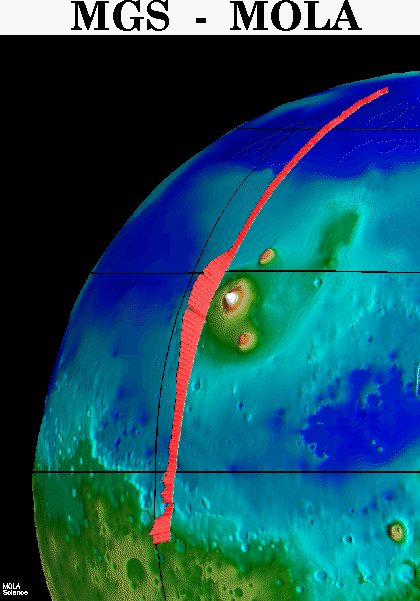
What the MOLA really does is send out a series of pulses (10 per second) of laser light that "bounce" off the Martian surface and are reflected back to the instrument’s receiver. This results in a single, circular “pixel” (or picture element) of data that is some 160 meters (over 500 feet) in diameter. Since the spacecraft is traveling at about 3.3 km/per second, the next "dot" is some 330 meters down track (since MGS is in a roughly polar orbit), leaving a gap, or blank spot in the image track about 170 meters (about 600 feet) wide. While the spacing is greater at the equator and less at the poles, it still requires multiple scans to accurately define any object visually. MOLA has been operating continuously since MGS went into the primary science phase, except when it was turned off during solar conjunction. So what the MOLA has produced is one continuous string of data, consisting of a series of 160 diameter spots, with 170-meter gaps in between them -- winding around the planet like a ball of twine for over two years. Sounds kind of cool, doesn't it?
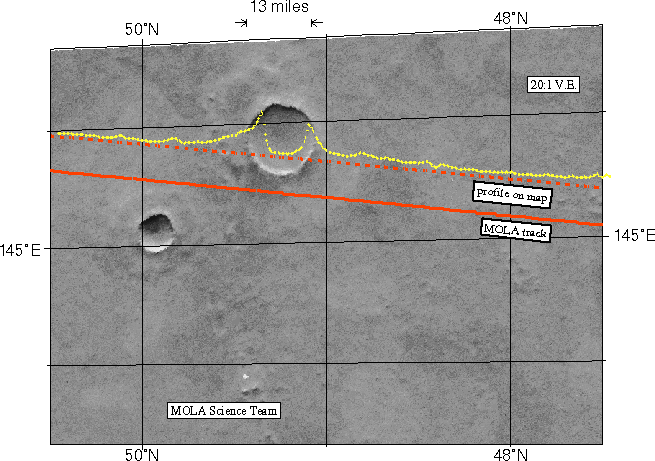
Well it is. But what it is not, is very specific or accurate on the scale of a mile or so. In other words, it is certainly incapable of “imaging” any individual object as small as The Face. Nor is it anywhere near the spatial resolution of the MGS camera, even at the latter’s worst. In the example above, from a MOLA press conference, you can see just how coarse the instrument “resolution” is. The example used above is a 13-mile wide crater, and the yellow dotted line represents the MOLA data track across it. As you can see, it is a series of dots, not one continuous scan, and it is only on a very narrow (160 meter) track -- missing well over 99% of the crater.
Some people have been confused by the stated "vertical" resolution of the MOLA. One particular critic here, seems to be utterly incapable of grasping just what the 20-30 centimeter "vertical" resolution of the instrument actually means. He has even gone so far as to suggest that because of that, the MOLA instrument is "better" for resolving features on the Martian surface than the MOC camera. As you will see, this is simply laughable. Didn't it occur to this genius that if that was the case, they wouldn't have even bothered to put a camera on the spacecraft – thereby saving perhaps a hundred million dollars, over the course of the entire mission?
Let's go back to the MOLA instrument and see if our critic is right.
Within that 160-meter diameter "dot" that we keep talking about, the MOLA can discern almost no detail. Its 10 quick pulses hit the ground in the area in question and return the timing data to the instrument. MOLA then takes the average altitude of the spacecraft above the ground within that 160-meter "pixel" and assigns a "value" to that pixel based on the average. As a result, every bit of detail within that pixel is reduced to a single point, a single value: the average spacecraft altitude above the ground being "pinged." All of the individual stuff within that 160-meter circle is completely lost. Now, that average value for the area in question is accurate to within about 1 meter with respect to the distance below the spacecraft, but that's it.
So just how big is "160 meters?" Just how much is missed by this (as our critics would have you believe) "precision" instrument?
A lot.
“160 meters” works out to about 525 feet -- which is a huge ”pixel” diameter.
It is, within about 5 feet, the diameter of the Tacoma Dome arena near Seattle (shown above at 1 meter per pixel resolution, 50% better than the MOC camera). Within its area, this sporting arena can hold upwards of 23,000 people, not to mention the playing field, the facilities, locker rooms, concession stands, press facilities, plumbing, miles of wiring and enough concrete to build a 50 mile long highway. And MOLA would miss it all! To MOLA, it would just be one big blob. A dot. It would be able to give a very close estimate of the average distance the roof of the dome was from the MGS spacecraft, but that is it. It could discern no details about the object whatsoever.
The argument has been made that “160-meter resolution” really isn't that bad, that it is "only" 3 times worse than Viking. But remember, “160 meters-per-pixel,” vs. Viking's “50 meters-per-pixel,” is a 150% difference. And when you consider the scale of the Face itself, it becomes obvious just how much crucial detail is missing from these “precision” MOLA scans.
To give you some idea of the scale involved here, I have placed the Tacoma Dome -- approximately to scale -- next to the Face on Mars. As you can see, the pixel size of the MOLA is so large that a feature like the eyeball in the eye socket (which is about the same size as the Dome) would be completely missed, assuming that by some miracle the MOLA scan actually ran across the feature in the first place.
By contrast, the MGS camera, at its maximum resolution of 1.5 meters per pixel, would "see" an area thousands of pixels "square" in this same 160-meter circular space. Objects as small as passenger cars could be made out without enhancement. And each of those pixels has a specific color value assigned to it from 256 available shades of gray. Enhancement processes can use these color values to bring out even more detail, effectively increasing the spatial resolution (under certain conditions and assumptions) even further.
So to argue that there are "no eyes, no nose, no mouth!", based on such a crude instrument (MOLA) is not only scientifically absurd -- it is scientifically dishonest. The simple truth is that MOLA is incapable of resolving a feature as small as the (Tacoma Dome sized!) eyeball. And the old-fashioned MOC camera, with its 1.5-meter dimensional resolution, and a "mere" 256 shades of gray-scale resolution, is thousands of times more accurate.
Which brings us to the next problem with NASA (and our critics) using MOLA data to “debunk” the Face.
There is, again, a general misunderstanding about just how the MOLA works. Because planets are so large, and individual features like the Face are so small by comparison, the chances of MOLA actually tracking directly across the Face in the course of its two-year “nominal” Mission were very small indeed. Our critic friend made up this grid pattern (below) to illustrate what he thought was the coverage pattern of the MOLA. He assumed that MOLA, like some kind of “scanning camera,” completely blanketed the Face in a tight grid-like pattern. In fact, once again, this is completely wrong -- but his grid overlay is useful for a couple of reasons.
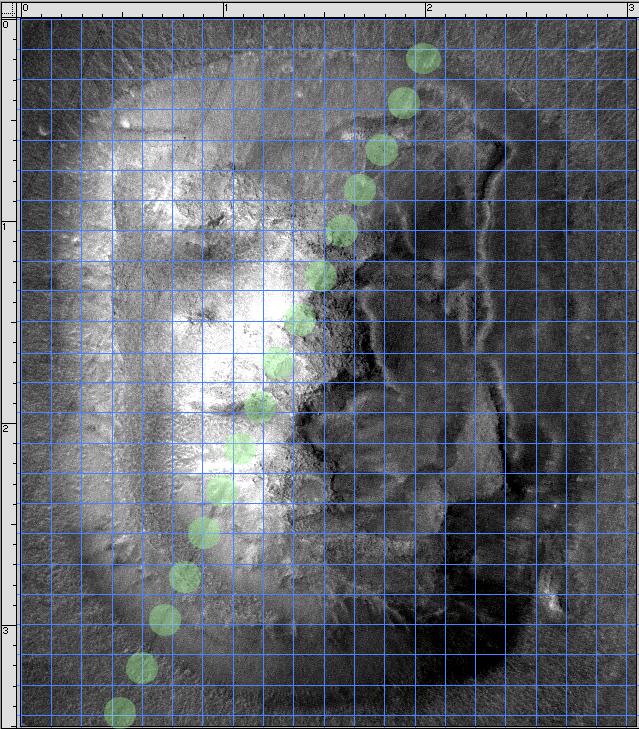
For starters, the image that he used still had visible CCD “pixel dropout” lines from the latest unprocessed MGS image of the Face. These less sensitive pixels, of the CCD “line camera” that makes up the heart of the MOC itself, represent the actual geodetic track around Mars that the MGS took over the Face, as it acquired this new image. In an ideal circumstance, MOLA would have tracked down right across the center of the Face along those darker “scan lines” (which are offset from true North by about 5°). I have added the green dots to represent the actual data pixels as they would have been acquired by the MOLA in an ideal "centerline" scan -- roughly every 160 meters (his grid is about 150 meters on a side), with the 170-meter gaps between the “pulses.”
As you can see, this is far different than the idealized notion (represented by his grid) that there were hundreds of MOLA data points taken across the Face. At best, there could only be between 15-20 points -- as you clearly can see from this example.
But wait a minute, why couldn't MOLA have made multiple passes across the Face, and gathered enough data to accurately measure the height of the entire object in its mission around Mars? After all, hasn't MGS been in orbit for years? Well, yes it has. But that has only amounted to about 10,000 orbits since MGS began the Mission Mapping Phase in March, 1998. This might seem like a lot of orbits, but since Mars is such an enormous place (with a surface equal to the land area of all the continents on Earth combined), it means that MOLA has only covered the planet sufficiently to date to leave 1.5-mile gaps between the “twine” (and, at the equator). At the latitude of the Face (41° North), the distance between tracks is somewhat less -- probably about 0.80 miles. Since the Face is only about 1.2 miles wide, it is highly unlikely that any subsequent parallel tracks actually scanned across the formation more than twice. This is because, since there has only been one direct overhead MOC shot of the Face released by Dr. Malin -- the one taken in June 2000 -- there can almost certainly be no more than two simultaneous samplings of MOLA data taken across the Face in the course of the entire mapping mission [because the first MGS image, taken in April 1998, and the latest one (above), were taken “off nadir,” so MOLA was not used]. And remember, that June 2000 example did not track accurately across the middle of the Face (see below), but was offset to one side (my example above is an ideal circumstance, merely to illustrate a point).
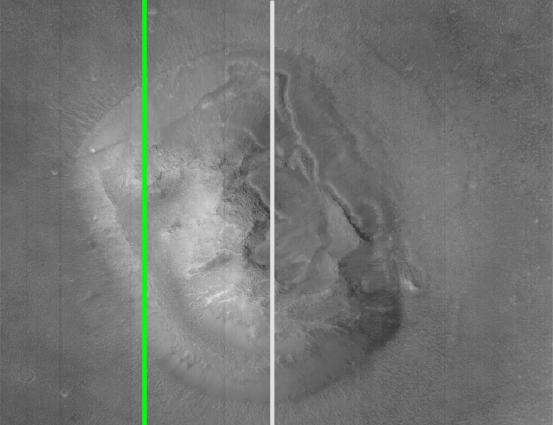
In fact, we can test all this rather easily.
If we assume that the unprocessed version of the latest off-nadir (~25-degree) Face image (above) has not been cropped, then the (bore sighted with the camera) MOLA scan (if the instrument was actually turned on) would have been pretty much right down the center of that frame. When you draw a simple line down the center of the unprocessed frame, as I have done (above), it becomes obvious that the best MOLA track (the white line) would have been off to the Cliff side, and clearly would have missed the tip of the “nose” -- which is the highest Facial point. The green line represents our estimate of the actual MOLA track of the June 2000 imaging opportunity, which would be theoretically right down the center of that frame. This notion -- that the MOLA scan NASA used in its (mis-) representations of the Face, missed the Nose completely -- is further reinforced by the claim made in the NASA hit piece: that the Face is “only” 800 feet tall. Previous estimates, made from reliable methods like comparative stereo images and measuring trigonometric shadow lengths, have shown that the Face is actually some 1,500 feet high at the nose tip. This discrepancy can be easily accounted for when you see that the MOLA scan that NASA actually used had to have tracked to the side of Face’s highest point (the Nose) -- completely missing the tallest feature on the Face! Unfortunately, our estimates cannot as yet be verified – as, for some reason, NASA has chosen not to release even the raw MOLA data they obtained during the June 2000 image pass.
But Jim Frawley, the contract scientist who is credited (along with NASA's Jim Garvin) as having created the "MOLA" image used in the NASA hit piece, admitted as much in an e-mail. When asked directly if there were only two MOLA passes over the Face, he responded "Your [sic] right. I found just two."
So, that's two passes: each a series of 15 to 20 dots, 160 meters in diameter, with absolutely no discernable detail about the "Tacoma Dome-sized” areas that MOLA scanned. How could NASA, from this meager data, decide that the Face was "800 feet" in height, and generate the supposed "3-D mesh" to create their now infamous "MOLA image" for the hit piece? How could they further decide, from just two scans that missed all these crucial facial features, that there was, as Garvin is quoted as emphatically stating, "No Eyes, no Nose, and no Mouth!"
They couldn't.
The fact is, there is no way for Garvin and Frawley to have created the “images” presented in the NASA “hit piece” from the available MOLA data. Further, it is equally impossible for them to have made any kind of accurate determination regarding the fine scale ("Tacoma Dome-sized “) features -- like the “eyeball” strikingly visible in the June 2000 image and in the April 8th, 2001 second detailed image.
These facts are in stark contrast to how the data was portrayed in the NASA hit piece (which was reprinted and treated uncritically on Space .com). This article argues that the Face is according to Garvin, "not exotic in any way." Of course it isn't, at the MOLA resolution!
NASA faked it -- pure and simple.
The image they are passing off as “MOLA-generated data” is nothing more than a deliberately "de-resed" version of the MOC image itself! Once again, confronted with this information, Frawley admitted to the truth. "You're right on this too. Image is 99% MOC. It's made with an 'inverse imaging' program I wrote some time ago. MOLA is used for constraints." "Constraints" simply means that he used the available MOLA data to make sure he had the height-to-width proportions correct when he made his shape-from-shading-image. And in reality, it's more like the image is 99.99% MOC ….
But why quibble? The key point here is that NASA has made outright false claims about the image they presented to the press and public as specific MOLA data, and compounded that lie by pretending that the instrument could determine more than it actually could. When that wasn't enough, they flipped the image upside down and stretched it to ensure it was totally distorted. To be fair to Frawley, he simply produced the image he was requested to produce. He had no control over how Garvin and the NASA hierarchy used and distorted that information to serve their own partisan political purposes.
And make no mistake, this article was all about “politics.” As we have shown, there was no science in Garvin's MOLA claim at all. In fact, like his other statement comparing the Face to Middle Butte Mesa (and then not even producing an image of the mesa to support his claim), Garvin has been shown to be lacking either the intelligence or the integrity necessary to carry out his duties as director of NASA's Mars projects. He is either ignorant of the capabilities of his own instruments, or was engaging in a deliberate deception. Either way, the reality is that the MOLA claims are not only false, but they were calculatingly designed to "scotch this thing for good," as one unnamed JPL "scientist" put it after the 1998 "Catbox" fiasco.
Tempting as it may be for some of our critics to fall back on the "honest but stupid" model, Garvin cannot escape judgment here by claiming mere “stupidity.” Surely he was well aware of the limitations of the MOLA instrument when he made his fallacious claims, just as he was aware the image was actually a deliberately degenerated MOC image. This shows that NASA is willing to go to considerable lengths to suppress interest in the Face -- even when forced (as in the FACETS campaign) to release images they'd obviously prefer to hide from the public.
But the tough question for our critics now is "why?" Why, if there is nothing to this quarter-century-old controversy of “a Face on Mars,” if the Face is so obviously a “natural and common geological formation,” does NASA need to go to such extraordinary and Machiavellian lengths to “prove” its point? Why do they need to make unsupportable comparisons and outright (and easily proven) fallacious claims about their own instruments … in an increasingly desperate and obvious effort to suppress all interest in a "natural" feature? Why do they need to withhold a full-on image of the Face for two months -- while they prepare their distorted “hit pieces,” rather than just release the image without comment … for the press and public to decide?
Why indeed.
The answer in fact, is staring you right in the Face.
Maybe it's time to actually look.
